BonnGravity2019 – The functioning of galaxies: challenges for Newtonian and Milgromian dynamics
A workshop at the University of Bonn, 23rd (Mo) - 27th (Fr) September 2019

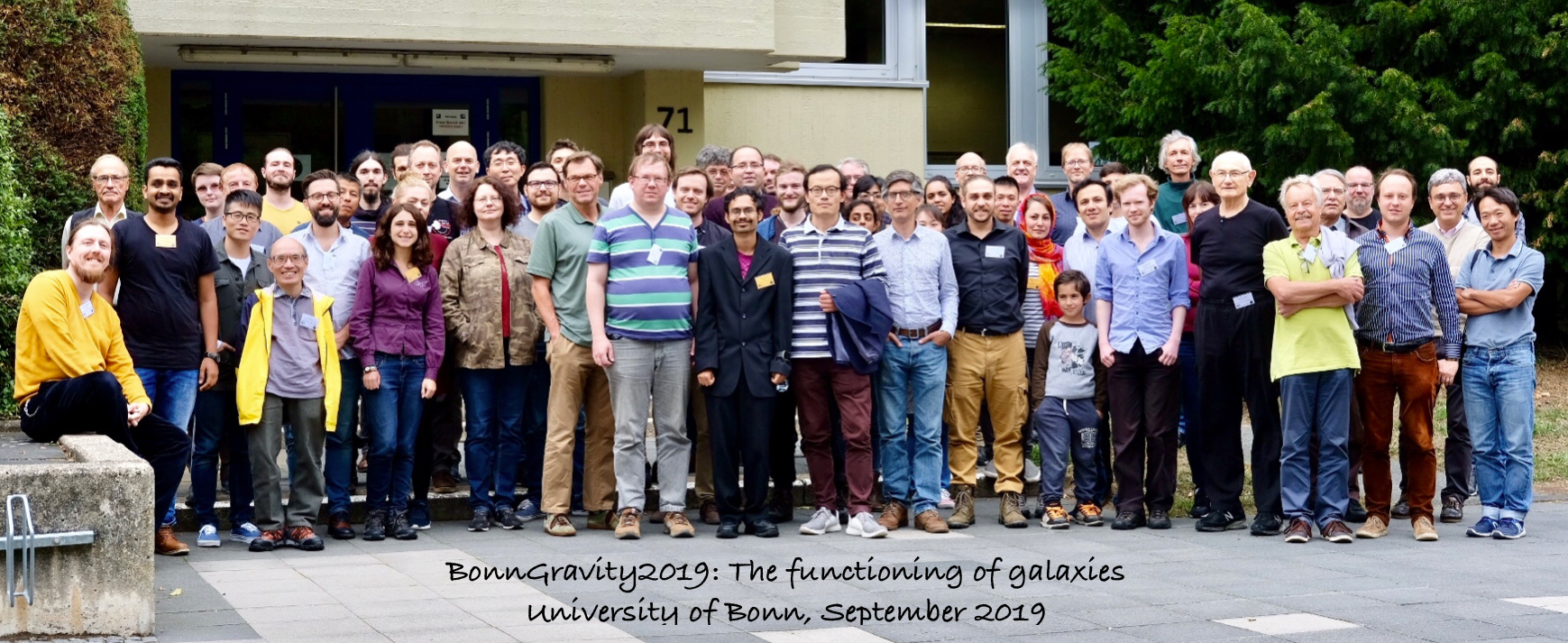
Bonn, 25.09.2019 (photo taken by M. Pawlowski = the leftmost yellow person)
About this workshop
One of the greatest current unsolved problems in physics is whether gravitation, the least understood of the fundamental "forces", is universally Newtonian in the classical limit. Even the nature of gravitation is unclear: is it a force in the physical sense (with an exchange particle), an apparent force resulting from the distortion of space-time or just an emergent phenomenon due to entropy differences as suggested by Verlinde? Whatever the physical origin of gravitation, the empirical formulation of how a body is accelerated as a result of the mass-distribution around it can be applied to study the formation and evolution of galaxies. There are two hypothesis available for computational study now:
The hypothesis that gravitation is Newtonian, as derived empirically based on Solar-system data only, has been embedded in Einstein's interpretation of gravitation as being a geometric space-time distortion. This interpretation leads to departures from observed motions of astronomical objects when extrapolated to the scales of galaxies and beyond. These departures are usually interpreted to be due to the existence of new elementary (dark matter) particles and due to the hitherto not understood dark energy which needs to dominate the energy content of the Universe and is increasing with time.
By taking into account the new dynamics data that became available on the scales of galaxies in the late 1970s, Milgrom generalised the classical law of gravitation. The hypothesis that gravitation is Milgromian simplifies galactic astrophysics because no additional dark matter is needed and galaxies become fully self-gravitating systems based on their baryonic matter content only.
The following challenges emerge in view of the two hypotheses:
Dark matter remains elusive: There is no room for dark matter particles within the standard model of particle physics. The decades long searches in space, underground and at the Large Hadron Collider for these putative particles have all been failures, and dynamical friction on the motions of satellite and larger galaxies due to the expansive dark matter haloes is not evident, as if dark matter particles are non-existent. In addition, already early cosmological computations based on the Newtonian hypothesis with dark matter have turned up major problems (e.g. the angular momentum problem, the missing satellite problem, amongst many) which have never been solved convincingly, while new problems keep emerging (the satellite planes problem, the radial acceleration relation problem, amongst many). Can this hypothesis nevertheless be made to be consistent with the observational data?
The Milgromian hypothesis on the other hand, while accounting for many of the above problems, is a non-linear theory and thus poses computational challenges. It has, until recently and due to a variety of reasons, not been applied to the problem of galaxy formation and it is therefore unclear if galaxies will emerge to look like the observed population in this approach.
With this meeting we aim to foster a discussion between the scientists who have been studying galaxies and cosmology in these two fundamentally different hypotheses. The aim is to achieve an exchange notably also on the technical challenges in applying both hypotheses to computational astrophysics problems in view of recent advances in understanding stellar populations, which are important for quantifying feedback processes.
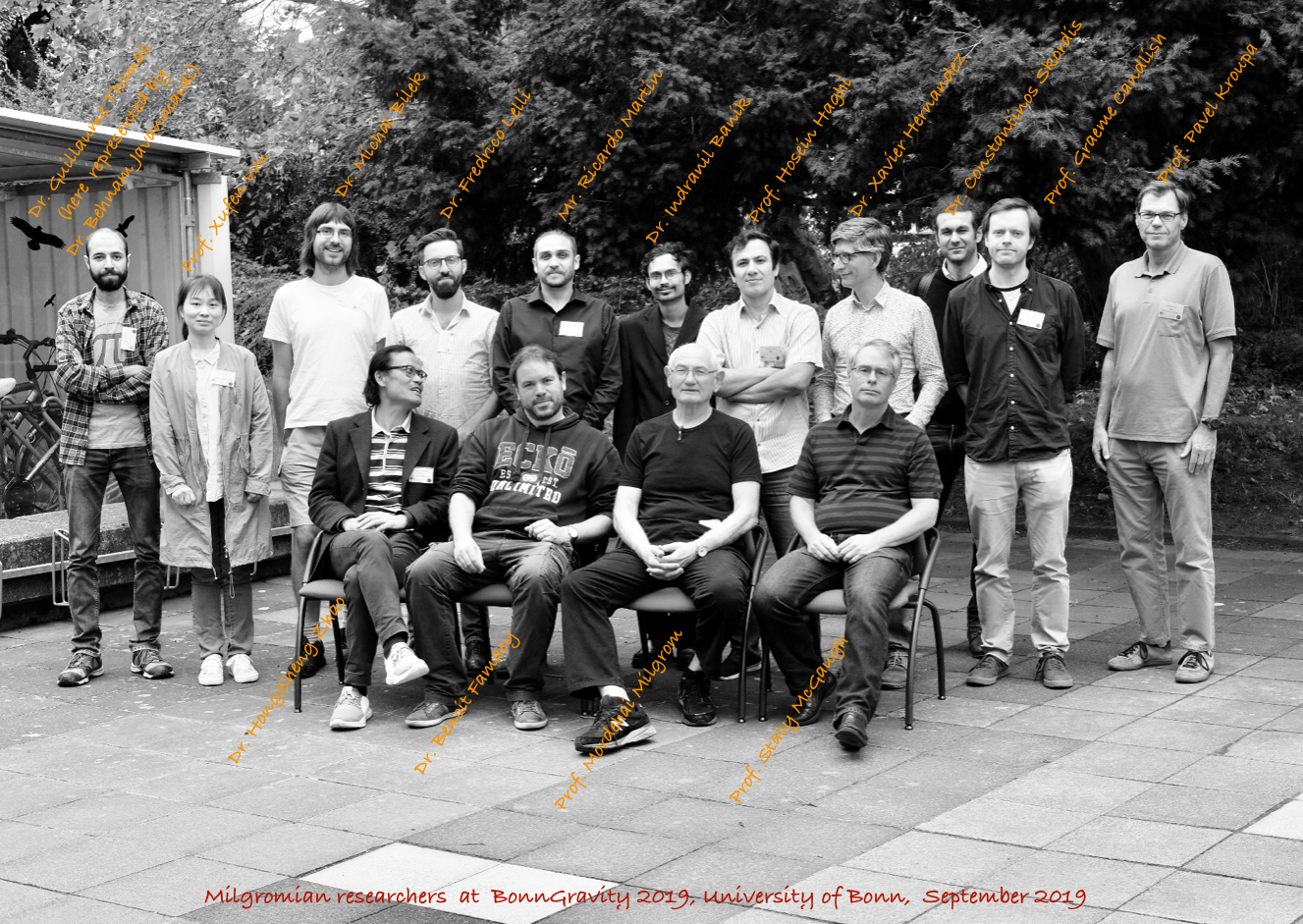
Milgromian researchers, Bonn, 25.09.2019 (photo by M.Pawlowski).
Registration
There is no registration fee, but financial assistance for
participants will not be available.
Registration has closed.
Moti Milgrom explaining (Bonn, September 2019; photo by J.Zdarska).
Programme and Slides
Conference talks and posters can now be accessed through links in the conference programme. We have the following outline: Monday morning to Friday afternoon (5 full days) typically in total 10 talks per day and a general discussion on Friday. Each talk has a time slot of 25 minutes plus discussion time. A conference dinner is planned for Wednesday evening.
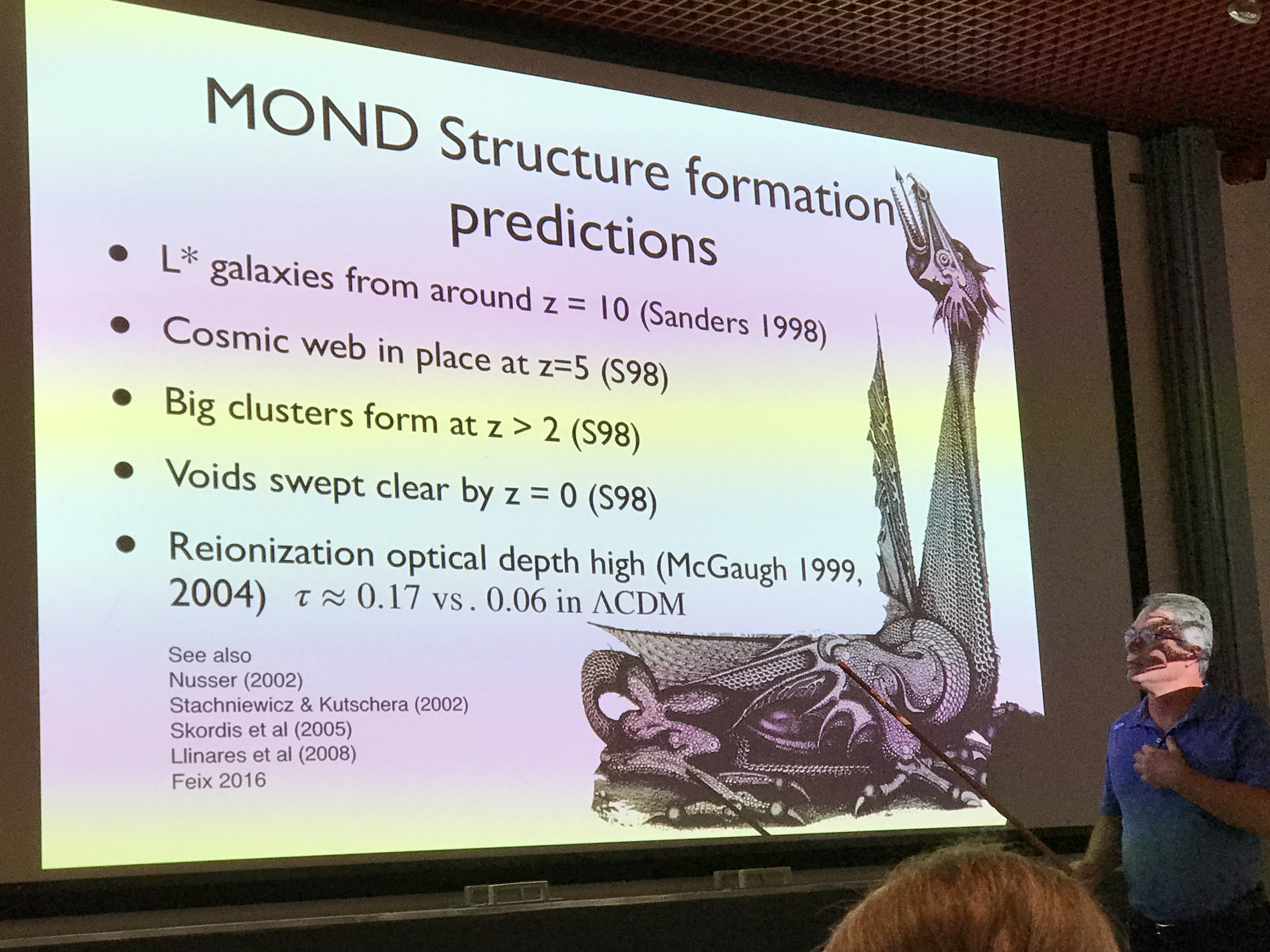
Stacy McGaugh on cosmology (Bonn, September 2019; photo by P.Kroupa).
Your Talk
For those giving an oral presentation, please contact your session chair in advance to inform the chair about your mode of presentation (via USB stick or your own computer). We do recommend using a USB stick in the computer permanently installed at the venue as connection risks are minimised this way. Speakers are kindly asked to upload their talk from the USB device with an appropriate name and check it before their presentation. For those preferring to give their presentation from their own computer, please also check it's functionality beforehand.
Moti Milgrom and Andre Maeder (Bonn, September 2019; photo by J.Zdarska).
Your Poster
For those presenting a poster: The poster boards have a maximum size of 2m by 1m. Thus, A1 (594 x 841mm) is the maximum size that will fit in any orientation, while A0 (841 x 1189 mm) posters only fit if they are portrait. Important: it is not allowed to use your own thumbtacks or glue tapes. We will provide special tapes to fix the posters on the boards.
BonnGravity2019 Booklet
The conference booklet is available here: BonnGravity2019 Booklet. It contains the programme and all abstracts with space for notes and will be provided to registered participants in the form of a bound book in A5 format.
Surveys
Below are graphs showing responses to the surveys held during the meeting, scaled to the number of respondents in the pre-conference survey (30). The idea is to estimate the impact of the conference on people's opinions. The red bars on the right are post-conference while the blue ones on the left are pre-conference.The first graph shows respondents' opinions to how long we should wait before putting more resources into modifications to conventional dynamical laws as an explanation for the galactic rotation curve anomalies. The majority thought we should already be doing this.
The second graph shows what new physics respondents thought actually causes these discrepancies. The first two options are low-luminosity 'dark matter' (DM) made of either particles within the standard model of particle physics (e.g. primordial black holes), or outside this model. The next two options are modifications to dynamics, either modified inertia (MI) or modified gravity (MG). There is also an option 'non-grav' that the discrepancies arise because most of the force holding a galaxy together is non-gravitational in nature, as occurs in e.g. the superfluid dark matter picture.
The third graph shows whether respondents thought the 'cosmic coincidence' of MOND is just a coincidence. This is the near-coincidence in acceleration scales between the MOND a_0 and that below which a gravitational field has less energy density than dark energy - the difference is less than an order of magnitude. It has been suggested that this is because MOND is a consequence of currently not understood quantum gravity effects which also cause the expansion rate of the Universe to accelerate.
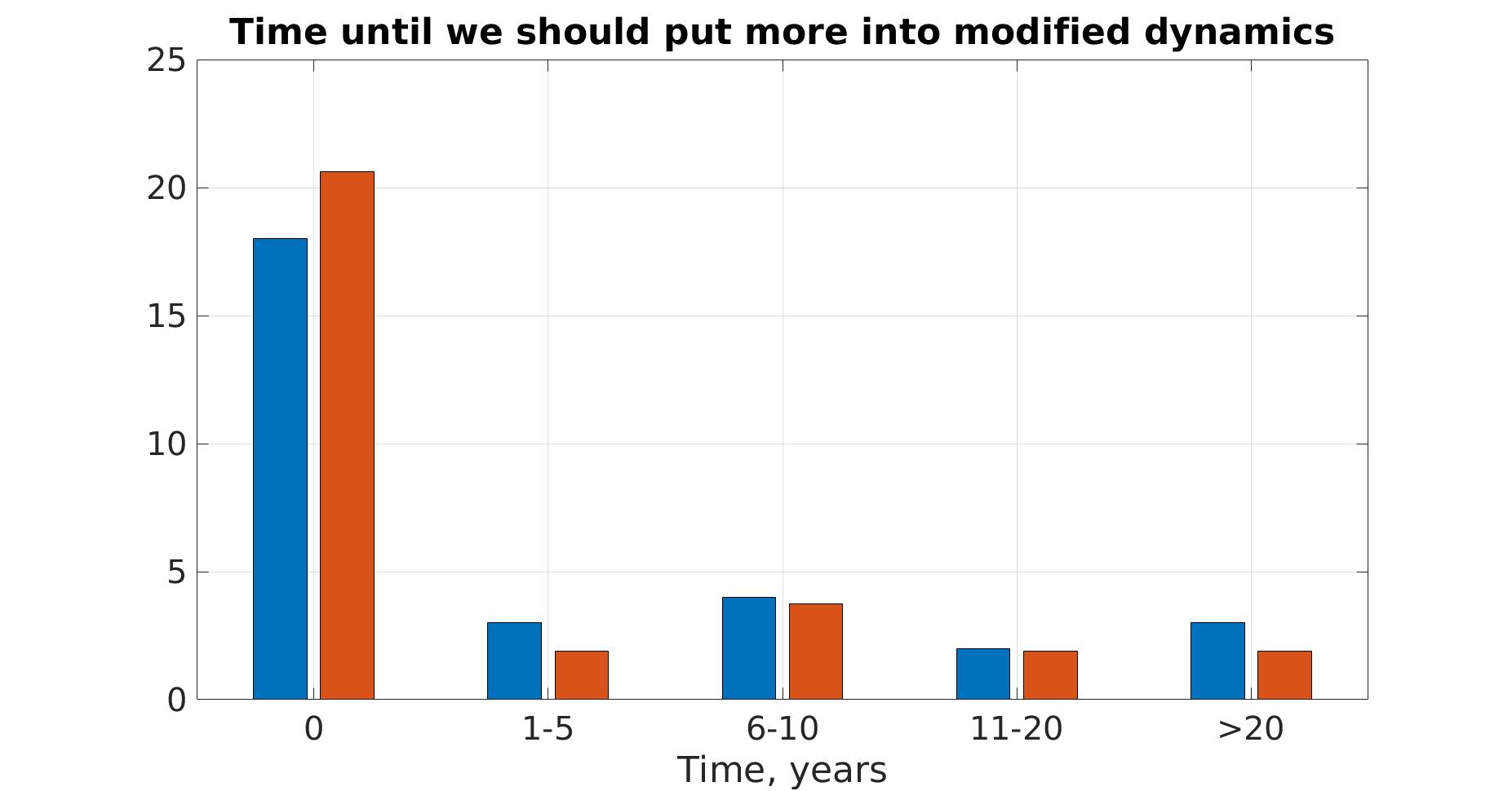

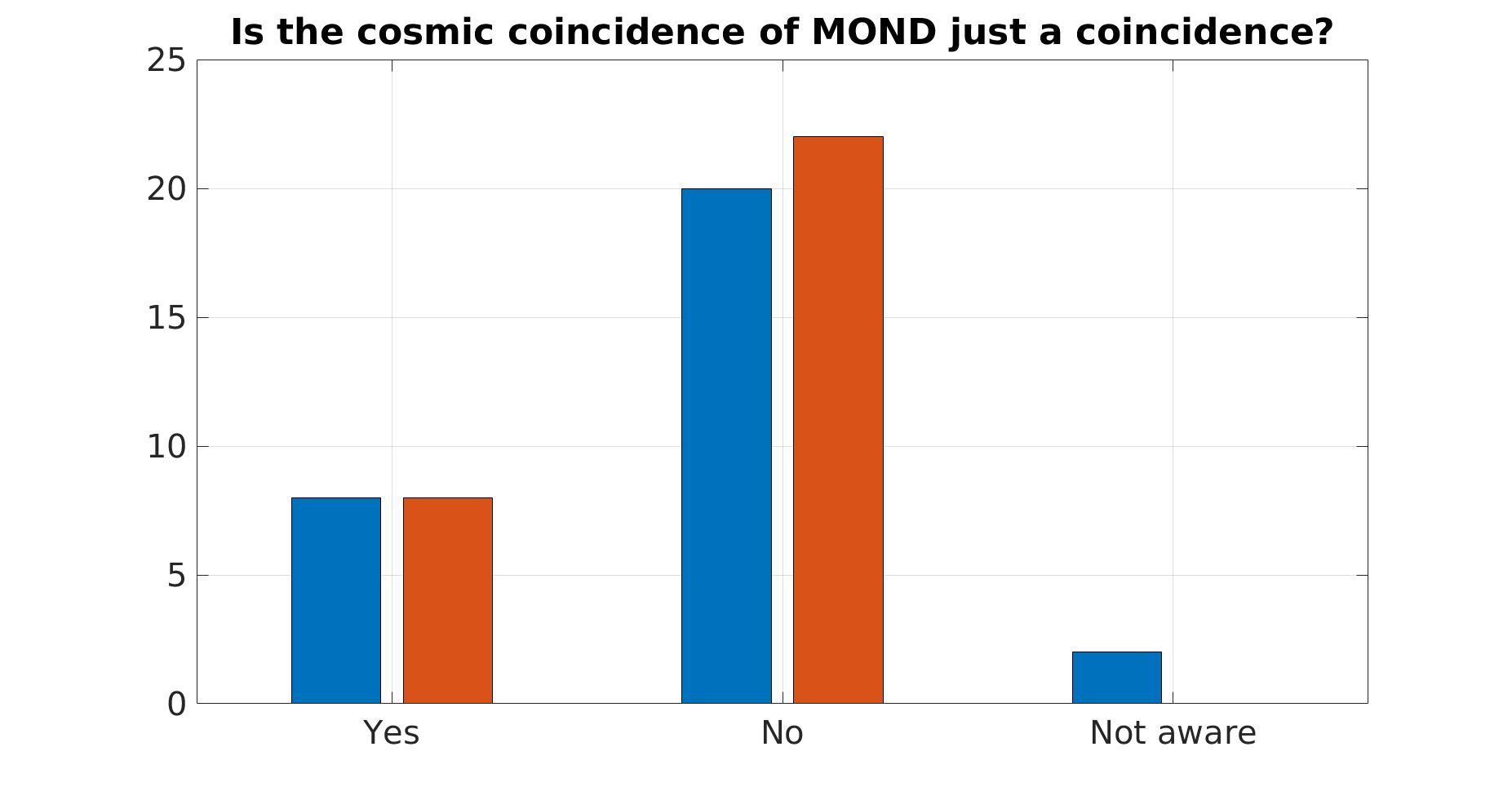
List of participants
06.09.2019
- Elena Asencio, University of Bonn, Germany
- Arunima Banerjee, Indian Institute of Science Education and Research, Tirupati C/o Sree Rama Engineering College (Transit Campus), Andhra Pradesh, India
- Sambaran Banerjee, University of Bonn, Germany
- Indranil Banik, University of Bonn, Germany
- Michal Bilek, Observatoire Astronomique de Strasbourg, France
- Mariano Cadoni, Universita di Cagliari, Italy
- Graeme Candlish, Universidad de Valparaíso, Chile
- Kyu-Hyun Chae, Sejong University, South Korea
- Joerg Dabringhausen, Astronomical Institute, Charles University, Prague, Czech Republic
- Harry Desmond, Astrophysics, University of Oxford, UK
- Antonaldo Diaferio, Universita degli Studi di Torino, Italy
- Andrea Dieball, University of Bonn, Germany
- Emilio Romano-Diaz, University of Bonn, Germany
- Mitali Damle, University of Potsdam, Germany
- Benoit Famaey, Observatoire Astronomique de Strasbourg, France
- Michael Fellhauer, Universidad de Concepcion, Chile
- Amith Govind, University of Bonn, Germany
- Enrico Garaldi, University of Bonn, Germany
- Hosein Haghi, IASBS in Zanjan, Iran
- Francois Hammer, Observatorie de Paris, Paris, France
- Moritz Haslbauer, University of Bonn, Germany
- Christian Henkel, Max-Planck-Institut fuer Radioastronomie, Bonn, Germany
- Gerhard Hensler, University of Vienna, Austria
- Xavier Hernandez, Ciudad Universitaria, Mexico City
- Michael Hilker, ESO, Garching, Germany
- Behnam Javanmardi, Obsevatorie de Paris, Paris, France
- Mandar Karandikar, University of Bonn, Germany
- Chung-Min Ko, Institute of Astronomy, National Central University, Taiwan and Department of Physics and Center of Complex Systems, National Central University, Taiwan, R.O.C.
- Kurt Koltko, Denver, Colorado, USA
- Pavel Kroupa, University of Bonn, Germany, and Charles University in Prague, Czech Republic
- Joseph Kuruvilla, University of Bonn, Germany
- Federico Lelli, ESO, Garching, Germany
- Pengfei Li, Case Western Reserve University, USA
- Andre Maeder, Geneva Observatory, Switzerland
- Niels Martens, University of Bonn, Germany
- Ricardo Adan Cortes Martin, Universidad Nacional Autonoma de Mexico
- Stacy McGaugh, Case Western University, Cleveland, USA
- Karl Menten, Max-Planck-Institut fuer Radioastronomie, Bonn
- Steffen Mieske, ESO, Santiago, Chile
- Konstantinos Migkas, Bonn University, Germany
- Mordehai Milgrom, Weizmann Institute, Israel
- Oliver Mueller, University of Strasbourg, France
- MSc student from Bonn
- Lavanya Nemani, University of Bonn, Germany
- Theo Nieuwenhuizen, University of Amsterdam, Holland
- Wolfgang Oehm, Bonn, Germany
- Marcel Pawlowski, AIP, Potsdam, Germany
- Jan Pflamm-Altenburg, University of Bonn, Germany
- Charalambos Pittordis, Queen Mary University of London, UK
- Tom Richtler, Universidad de Concepcion, Chile
- Donatella Romano, INAF-Osservatorio di Astrofisica e Scienza dello Spazio di Bologna, Italy
- Mahmood Roshan, Dept. of Physics, Ferdowsi University of Mashhad, Iran
- Riccardo Scarpa, Instituto de Astrofísica de Canarias, Spain
- Govert Schilling, science writer, es Amersfoort the Netherlands
- Erhard Scholz, University of Wuppertal, Germany
- Earl Schulz, North Granby, CT 06060, USA
- Jennifer Schulze, University of Bonn, Germany
- Victoria Schuy, University of Bonn, Germany
- Constantinos Skordis, Central European Institute for Cosmology and Fundamental Physics, Prague, Czech Republic
- Sitara Srinivasan, R N S Institute of Technology (RNSIT), Bangalore, India
- Yong Tian, Institute of Astronomy, National Central University, Taiwan, R.O.C.
- Ingo Thies, University of Bonn, Germany
- Guillaume Thomas, NRC Herzberg Astronomy & Astrophysics, Canada
- Roy Truelove, St. Andrews, UK
- Vaclav Vavrycuk, Institute of Geophysics, Czech Academy of Sciences, Prague, Czech Republic
- Viola Vavrycukova, University of Durham, UK
- Stella Vjesnica, University of Bonn, Germany
- Nils Wittenburg, University of Bonn, Germany
- Richard P. Woodard, University of Florida, Gainsesville, USA
- Xufen Wu, Hefei, China
- Yanbin Yang, Paris Observatory, GEPI, France
- Jana Zdarska (Czechoslovakian Journal for Physics, science writer), Physics Institute of the Academy of the Sciences, Na Slovance 2, Praha, Czech Republic
- Hongsheng Zhao, St. Andrews University, Scotland
- Akram Hasani Zonoozi, University of Bonn, Germany, and IASBS in Zanjan, Iran
List of hotels
Please arrange your own travel schedule and accommodation. There are many hotels in Bonn. Within walking distance (20-30 minutes) for example:
Map
Similar conferences and The Debate
The two presentations
The debate
The final debate afterwards
SOC, LOC and Contact
SOC: Indranil Banik (chair, Bonn), Hosein Haghi (Zanjan), Pavel Kroupa (co-chair, Bonn, Prague), Oliver Müller (Strasbourg), Xufen Wu (Hefei), Akram Hasani Zonoozi (Bonn, Zanjan)
LOC: Elena Asencio, Indranil Banik, Andrea Dieball, Hosein Haghi, Moritz Haslbauer (chair), Pavel Kroupa, Srikanth Togere Nagesh, Jan Pflamm-Altenburg, Victoria Schuy, Nils Wittenburg, Akram Hasani Zonoozi
gravity2019@astro.uni-bonn.de
